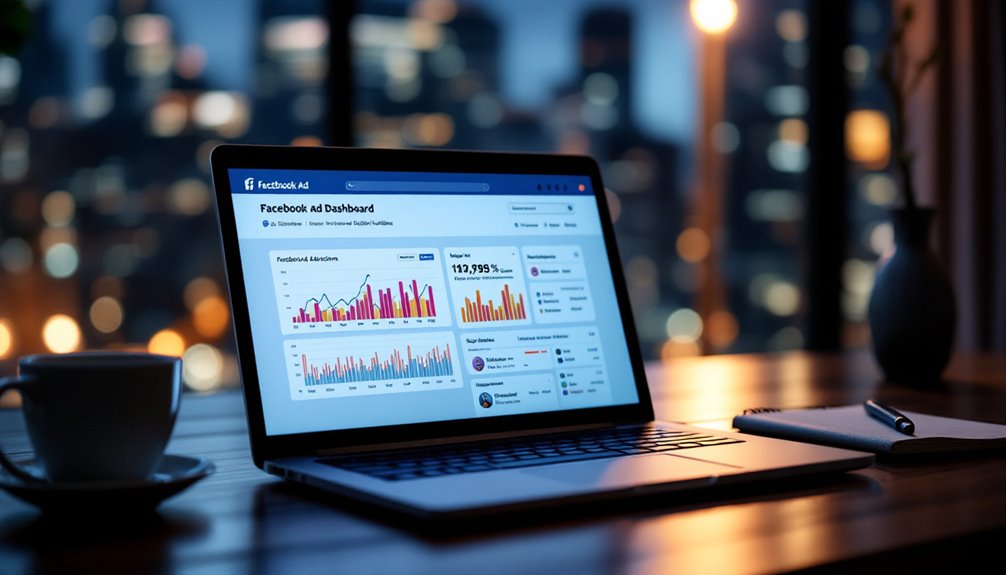
Are Facebook traffic ads worth it?
When you consider using Facebook Traffic Ads, you’re likely weighing their potential benefits against the cost and effort involved. These ads promise to drive users to your website or app, but are they truly worth the investment? With an average cost-per-click that seems reasonable and conversion rates that could boost your business, the allure is there. However, the effectiveness can vary widely by industry and strategy. So, what factors should you really focus on to make an informed decision? Let’s explore some critical insights and strategies that might just tip the scales in favor of these ads.
Key Takeaways
- Facebook Traffic Ads effectively drive users to websites, apps, or events through targeted audience engagement.
- They offer cost-effective solutions with CPC averaging 72¢ and CPM at $13.75 per 1,000 impressions.
- High-quality visuals and compelling text significantly enhance ad performance and user interaction.
- Advanced targeting options and retargeting capabilities optimize ad spend and improve conversion rates.
- Traffic ads provide valuable data insights for refining advertising strategies and achieving a higher ROI.
Understanding Facebook Traffic Ads

Understanding Facebook Traffic Ads begins with recognizing their primary objective: to drive users to a specific destination such as a website, app, or event. By effectively leveraging Facebook’s targeting capabilities, you can reach precise demographics and interests, guaranteeing your message resonates with your target audience.
These ads utilize various ad formats, including single image, video, carousel, and slideshow, allowing for creative flexibility. Each format can be tailored with compelling calls-to-action like “Shop Now” or “Learn More,” enhancing user engagement.
To maximize impact, focus on high-quality visuals and concise ad copy that clearly communicates your value proposition. Optimizing for mobile guarantees seamless user experience, vital for capturing attention. The cost-effectiveness of these ads often makes them a popular choice, with average costs ranging from $1.01 to $5.00 per 1000 impressions, which allows businesses to manage their budgets efficiently.
Strategic audience targeting and format selection pave the way for effective traffic generation and potential customer engagement.
Cost Analysis of Traffic Ads
When diving into the cost analysis of Facebook Traffic Ads, it’s vital to recognize the financial metrics that influence your advertising budget. Consider CPC trends, where the average hovers around 72¢ as of November 2024, influenced by audience, industry, and seasonality. CPM variations, significant for brand awareness, average at $13.75 per 1,000 impressions, fluctuating with industry and campaign timing. According to industry benchmarks, the average expected ROI is 1.7 times the ad spend, which varies depending on the sector. These metrics highlight:
- Cost Per Click (CPC): Varies from $0.50–$3.50.
- Cost Per Thousand Impressions (CPM): Ranges $12–$20.
- Cost Per Lead (CPL): Averages $5.83 per lead.
- Overall Ad Spend: Typically $1.00–$500.00 monthly.
- Return on Investment (ROI): Averages 1.7 times the ad spend.
Strategically monitoring these factors enhances the potential for innovative advertising success.
Click-Through Rate Insights

When analyzing Click-Through Rates (CTR) for Facebook Traffic Ads, you’ll notice significant variations across industries, with retail leading at 1.59% compared to the overall average of 0.90%. Monitoring Facebook Ad CTR involves using Meta Ads Manager to track click-through rate (CTR) and other metrics, including unique clicks and outbound CTR. To optimize ad performance, focus on enhancing ad relevance and precise audience targeting, as these factors directly influence CTR outcomes.
Industry CTR Comparisons
Although click-through rates (CTR) for Facebook traffic ads vary greatly across different industries, analyzing these variations can provide strategic insights for optimizing ad campaigns.
Understanding industry-specific CTR benchmarks can greatly enhance your advertising strategy. The median CTR across industries is 1.80%, but standout sectors like Weddings & Events achieve a 3.01% median CTR, demonstrating potential above industry standards. Facebook boasts over 2.9 billion daily users, making it a significant platform for reaching diverse audiences.
Targeting high-performing industries offers lucrative opportunities:
- Arts & Entertainment: 2.55% CTR
- Real Estate: 2.45% CTR
- Restaurants & Food: 2.29% CTR
- Apparel & Fashion: 2.64% median CTR
- Weddings & Events: 3.01% median CTR
Stay strategic by aligning your campaigns with industry dynamics.
Consider audience demographics, ad formats, and competition to leverage these insights effectively. This data-driven approach can guide you to innovate and outperform your competition.
Optimizing Ad Performance
Boosting your ad’s click-through rate (CTR) is vital for maximizing its performance and cost-effectiveness. Start by enhancing ad relevance through precise audience targeting. Identify your ideal demographic to guarantee your ads reach individuals most likely to engage. A/B testing is essential—experiment with different ad creatives to discover what resonates best. Analyze data to refine visuals, headlines, and calls to action, leveraging insights to drive engagement. Don’t overlook timing; launch ads when your target audience is most active. Regularly compare your CTR against industry benchmarks to gauge success and adapt strategies. The higher the CTR, the more Facebook rewards your ad with better placements and lower costs, ultimately driving innovation in your campaign strategy. Monitoring frequency is also crucial to avoid audience fatigue and ensure sustained engagement.
Conversion Rate Comparisons
Understanding conversion rate comparisons is crucial for leveraging Facebook traffic ads effectively. Remarkably, conversion trends reveal that the average Facebook ad conversion rate stands at 9.21%, surpassing Google Ads. Your campaign objectives greatly influence these rates. For instance, conversion-focused campaigns generally outperform traffic objectives by targeting users with higher intent. Although conversion objectives might incur higher costs, they often result in a lower cost per conversion. Notably, the highest conversion rates are found in the Fitness industry, reaching an impressive 14.29%.
Strategically:
- Lead generation campaigns average an 8.25% conversion rate.
- Fitness industry rates soar to 14.29%.
- Retargeting boosts click-through rates by 600%.
- High-intent targeting guarantees better conversion outcomes.
- Initial rates may start low at 2-3%, yet improving over time is feasible.
Industry Performance Metrics

Industry performance metrics provide essential insights for enhancing Facebook traffic ads. Understanding CTR benchmarks can guide you towards industries like Weddings & Events with a 3.01% CTR, indicating strong audience interest. Moreover, analyzing the conversion rate reveals how well ad traffic leads to conversions, with typical benchmarks around 2-5% for e-commerce. Conversely, lower CTR in areas like Roofing (1.08%) suggests challenges in audience targeting or ad quality. CPC variations reveal budget allocation efficiency, where lower CPCs denote cost-effective traffic, while higher CPCs might highlight valuable audience segments. Conversion trends, particularly in Education and Apparel, underscore the potential financial impact of industry-specific campaigns. Analyzing ROAS expectations helps set strategic goals, guiding budget allocation to enhance returns. Use competitive analysis and industry comparisons to refine strategies, ensuring your campaigns align with performance metrics and achieve optimal results.
Evaluating Ad Effectiveness
To effectively evaluate your Facebook traffic ads, focus on analyzing click-through rates and conversion rates, as these metrics directly reflect user engagement and campaign success. Facebook Pixel plays a crucial role in gathering valuable data post-ad launch, which is essential for understanding audience engagement and behavior. You’ll want to strategically leverage data insights to assess cost-effectiveness, ensuring your budget is optimized for maximum return.
Analyzing Click-Through Rates
How do you measure the effectiveness of your Facebook traffic ads? Start by analyzing click-through rates (CTR), a critical metric that reflects ad performance. Higher CTR indicates effective ad messaging and targeting, which are essential for optimizing your campaigns. Key CTR factors include ad relevance, quality, and timing. High-impact
ad formats, like carousel ads, can achieve up to 0.85% CTR, leveraging visually engaging content.
Consider these points strategically:
- Ad Relevance: Tailor your ads to user interests for better engagement.
- Ad Quality: Use high-quality visuals and compelling text to capture attention.
- Target Audience: Verify your ads are reaching the right people for peak results.
- Platform and Placement: Choose the best performing formats, such as FB Instream Video.
- Industry Benchmarks: Compare your CTR with industry averages for context.
Strategically enhance these elements for innovative ad success.
Conversion Rate Insights
When evaluating the effectiveness of your Facebook traffic ads, conversion rate insights offer a strategic lens through which to gauge success.
Understanding conversion rate factors is essential, with industry benchmarks like fitness at 14.29% or travel at 2.82% guiding your analysis. The conversion rate formula—(Number of conversions / Number of visitors) x 100—helps quantify ad impact. High conversion rates often result from high-intent users and effective landing pages. Conversion rate strategies involve optimizing targeting with Facebook’s demographic and interest tools, utilizing retargeting, and refining ad content based on performance metrics. Regular analysis of key metrics such as conversion rates ensures that campaigns are aligned with audience preferences and changing platform dynamics.
Cost-Effectiveness Evaluation
Evaluating Facebook traffic ads means looking beyond conversion rates to understand the cost-effectiveness of your campaigns. With advanced targeting options, you can precisely reach your target audience, optimizing ad spend for maximum impact. Facebook’s diverse ad placements and formats allow you to tailor your ads to fit specific campaign goals, ensuring your content resonates with users across platforms. Budget efficiency is a key strength, offering affordable CPC and CPM rates to reach broader audiences without overspending. Additionally, traffic ads provide critical data insights, refining strategies by understanding user behavior. Consider these benefits: Facebook traffic ads are designed to increase online presence by driving traffic to websites, providing an opportunity to boost site traffic and encourage product exploration.
- Demographic and interest-based targeting
- Flexible ad placements and formats
- Affordable cost-per-click (CPC) rates
- Valuable data for strategy refinement
- Broadened reach with lookalike audiences
Engagement and Reach Potential

Understanding Facebook’s engagement and reach potential is essential for optimizing your advertising strategy. By analyzing engagement metrics, you can identify which post types drive the most interaction. Photo posts lead with a 0.10% engagement rate, while link posts lag at 0.03%. Despite these low percentages, organic engagement averages 3.91%, indicating opportunities for genuine interaction. Facebook ranks as the third-most downloaded mobile app in the U.S., further emphasizing its wide accessibility to users. Regarding reach strategies, Facebook offers an impressive potential ad reach of 2.19 billion users, with men aged 25-34 comprising a significant 19% of this audience. This expansive reach is complemented by the platform’s status as the third-most downloaded app in the U.S., highlighting its accessibility. Leveraging strategic engagement and reach enhances your ad’s performance, positioning you for success in a competitive digital landscape.
Optimizing Ad Strategies
To truly capitalize on Facebook’s immense reach and engagement potential, honing your ad strategies is the next logical step.
Start by focusing on optimizing ad targeting to reach your ideal target audience. Employ demographic targeting by age, location, and specific traits. Utilize custom audiences from website interactions and CRM data. Implement detailed targeting to layer interests and behaviors for precision. Leverage behavioral targeting to connect with users showing purchase intent. Retargeting campaigns can re-engage previous visitors, ensuring that potential customers who did not convert on their first visit are reminded of your offerings.
Enhance your ad placement strategy with dynamic creative features, allowing Facebook to automatically optimize ad components. Conduct A/B testing to identify high-performing elements and adjust accordingly.
- Target urban or rural audiences based on product relevance
- Exclude non-relevant demographic groups
- Sync CRM data for custom audience creation
- Optimize creatives with dynamic features
- Conduct consistent A/B testing
Choosing the Right Pricing Model

How do you determine the best pricing model for your Facebook ad campaigns? Start by aligning your campaign goals with model selection.
If you’re aiming for high traffic, the Cost-per-Click (CPC) model, with its average cost of $0.65, is ideal, though costs can rise for targeted audiences.
For brand awareness, consider the Cost-per-Mille (CPM) model, with an average of $9.88 per 1,000 impressions, making it effective for reaching wide audiences.
If lead generation is your focus, the Cost-per-Lead (CPL) model, averaging $12.67, offers high value by acquiring customer contact details. The specificity of your target audience can significantly affect these costs, as highly competitive segments often lead to increased expenses.
Incorporate strategic bidding strategies like spend-based or goal-based to refine your pricing strategies, ensuring that your ad spend aligns with your conversion goals and maximizes your return on investment.


